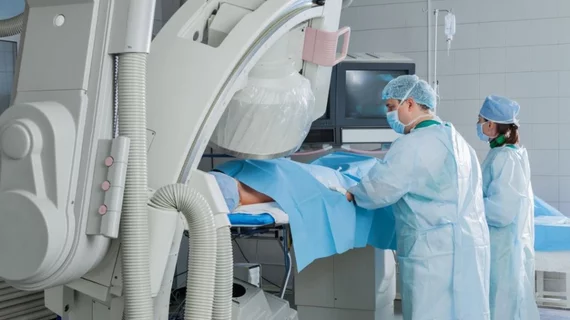CT angiography cost-effective for detecting LVO in patients with minor stroke
CT angiography—preferably followed by immediate thrombectomy—was cost-effective and beneficial for triage in a recent study of patients with acute minor stroke, researchers reported in Radiology Jan. 14.
First author Xiao Wu, BS, and colleagues at the Yale School of Medicine explained that while minor strokes represent up to two-thirds of all cases of acute ischemic stroke, it’s still unknown whether CT angiography (CTA) to assess large-vessel occlusion (LVO) in minor stroke patients is cost-effective. LVO may be present in around 18% of patients with National Institutes of Health Stroke Scale (NIHSS) scores of 0-4 and 39% of patients with NIHSS scores of 5-8, but the authors said CTA is only recommended in clinical guidelines for potential candidates of mechanical thrombectomy.
For stroke survivors with an NIHSS score of 6 or greater, current guidelines endorse endovascular thrombectomy, which has led to wider use of CTA.
“Because current guidelines recommend endovascular thrombectomy only in patients with NIHSS scores greater than 6, acute vessel imaging in patients with milder symptoms may not be routinely performed,” Wu et al. wrote in Radiology. “Thus, many of these cases are missed and not appropriately treated.”
The team evaluated the cost-effectiveness of CTA in detecting LVO in patients with acute minor stroke, which is defined as an NIHSS score of 6 or lower. They compared three different management strategies with a decision-analytic model: No vascular imaging and best medical management; CTA for all patients followed by immediate thrombectomy for LVO after intravenous thrombolysis; and CTA for all and best medical management, including intravenous thrombolysis, with rescue thrombectomy for patients with both LVO and neurologic deterioration.
CTA followed by swift thrombectomy came out on top, with the lowest cost ($346,007) and greatest health benefits (9.26 quality-adjusted life-years, or QALYs) of the trio. Best medical management with possible rescue thrombectomy was slightly pricier ($346,500) with fewer health benefits (9.09 QALYs), and no vascular imaging resulted in the greatest costs and fewest benefits.
Wu and colleagues said the difference in benefits compared with CTA plus immediate thrombectomy was 0.39 QALYs, translating to 142 days in perfect health per patient. The net monetary benefit of performing CTA was highest in younger patients—there was a $68,950 difference between CTA plus immediate thrombectomy and no vascular imaging in 55-year-old patients, compared to a $20,931 difference in 85-year-old patients.
“Our study findings emphasize the utility of early CT angiographic detection of LVO to improve health outcomes and reduce overall costs,” the team wrote. “The costs incurred in faster and better selection of patients for mechanical thrombectomy must be seen in the overall context of cost savings from better outcomes.”

